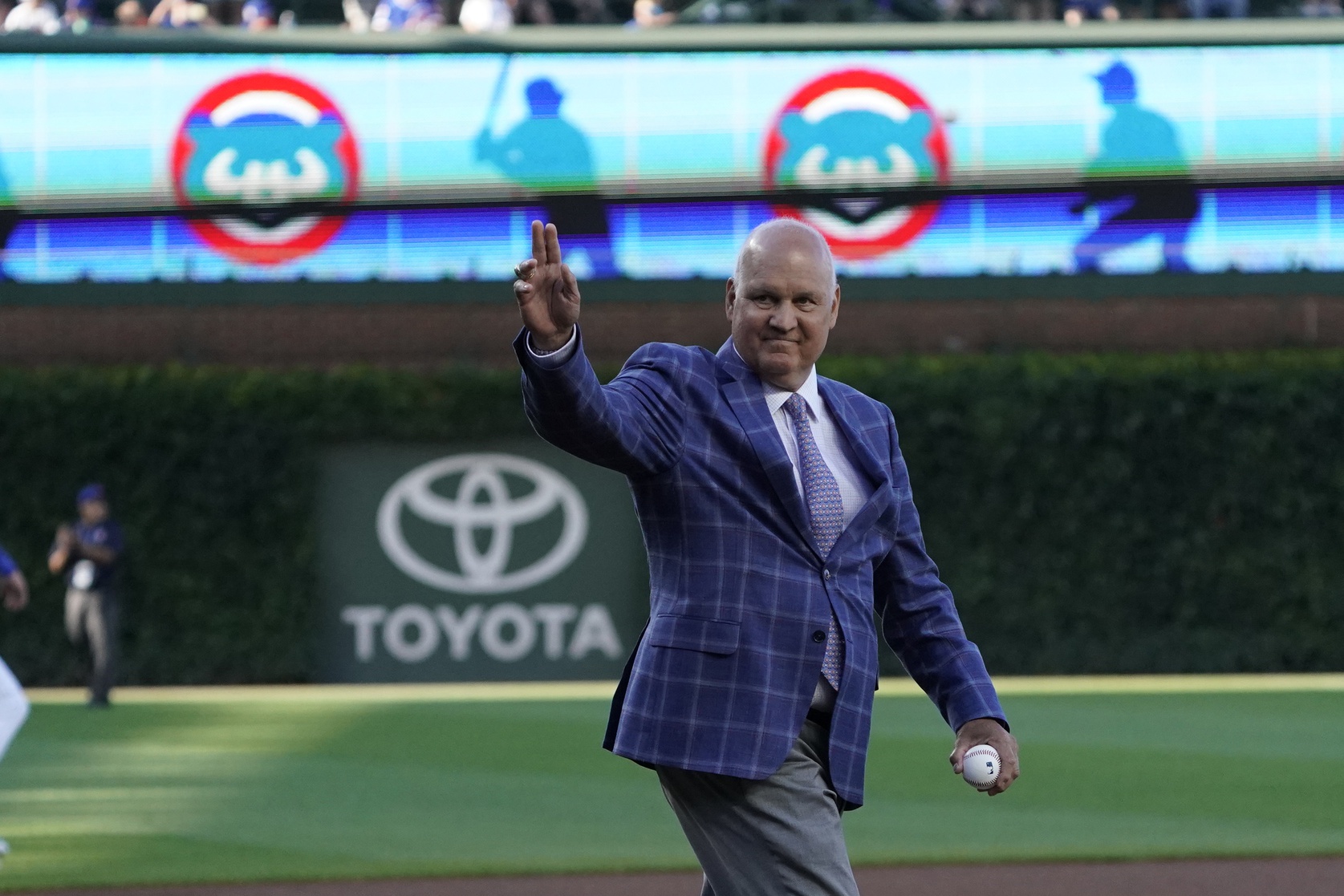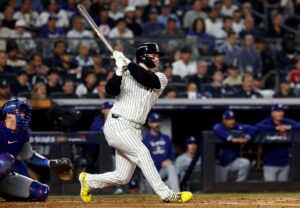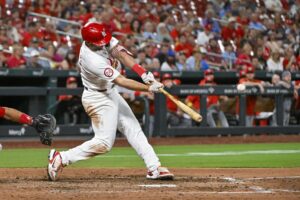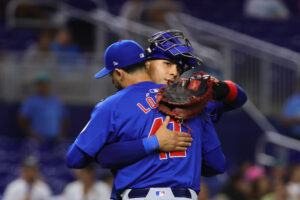On September 24, 1984, the Chicago Cubs clinched the National League East Division title at Three Rivers Stadium in Pittsburgh. They beat the Pirates, 4-1, and won their first title since 1945, when they won the NL pennant but lost to the Detroit Tigers in the World Series.
40 Years Ago: Cubs Clinch 1984 NL East Division Title in Pittsburgh
In the interim, there was much suffering for Cubs fans, probably never worse than in 1969. That year they were 84-52 on September 2, five games ahead of the New York Mets in the NL East. Then they came unglued. The Cubs went 8-18 the rest of the way. The highlights – or lowlights, depending on one’s perspective – included a black cat crossing their dugout at Shea Stadium, much to the delight of Mets fans, pitcher Dick Selma throwing wildly from the mound to an unoccupied third base, allowing a run to score in a one-run loss, and third baseman Ron Santo screaming at center fielder Don Young. Meanwhile, the Mets went 23-7 over that same stretch and won the division and the World Series.
The Cubs had good teams in 1970-72 but always finished behind the Pirates, who dominated the division during that time. Their top starting pitcher, Fergie Jenkins, was 66-41 during that period but never seemed to beat the Pirates in a big game. Indeed, he was 14-23 against Pittsburgh for his career.
“No, He Weren’t”
A lifelong Pittsburgh resident, I suggested to my fiancé – who would become my wife the following month – that we go to the game and possibly see the Cubs clinch the East title. I reasoned that if the Cubs won, we’d witness history. If the Pirates won, it would be fun seeing them spoil it for Chicago for one night.
On the way to the game, I thought back to those Cubs teams of 1969-72. I thought back to 1974 when I was 16 years old and worked at a fast-food restaurant. One afternoon, I took my lunch break at a ball field behind the restaurant, where I fell into conversation with an old man as a Little League game took place. (An old man, I thought then, but probably not much older than I am now.) He said he was a friend of Emil Verban, a Cubs second baseman from 1948-50. The name was vaguely familiar to me, but to be polite, I said, “He was a good ball player.”
“No, he weren’t,” the old man sniffed. “He stunk.”
Wow, I thought, it’s been so tough for Cubs fans, their players can’t even get any respect from their friends. (It turned out that in my ignorance, I was right. Verban played for four teams from 1944-50. For his career, he hit .272/.301/.325. He was a three-time All-Star. Twice he received votes for the NL Most Valuable Player Award.)
Welcome to 1984
Meanwhile, 10 years later, the Pirates had a dismal season. They had mostly been contenders, and once a World Series champion, since Chuck Tanner became their manager in 1977. It was hard for Pirates fans to imagine another team, let alone the Cubs, clinching a title in Pittsburgh.
However, in 1984, the Pirates finished in last place, thanks mostly to a weak offense devoid of power. In 1983, they were strong in starting pitching and light on offense. Dave Parker then departed to his hometown Cincinnati Reds as a free agent, setting off a series of curious moves. General manager Hardy Peterson’s head-scratching response was to trade Mike Easler, a good hitter, to the Boston Red Sox for another starting pitcher, John Tudor. The 37-year-old Amos Otis was brought in to replace Easler in left field. Taking over for Parker in right field was Doug Frobel, a lanky, overmatched Canadian rookie who hit .203/.271/.388 with a 27.5 percent strikeout rate. By the time the Cubs came to Pittsburgh to clinch the 1984 NL East title, Otis was no longer a Pirate.
It’s Not Easy Being Green
The 1984 Cubs were assembled by general manager Dallas Green, a six-foot-five, large, loud baseball man. Green managed the Philadelphia Phillies to the World Series title in 1980. But his strict, no-nonsense ways didn’t play well with a Phillies team largely made up of divas, and he was hired by the Cubs in October 1981. With an aggressive series of signings and trades, Green began to rebuild the Cubs, mostly with players with whom he was familiar from his time with Philadelphia.
For that, Green was the subject of ridicule. The Phillies had discarded these players on the way to a pennant-winning 1983 season. In 1984, the Cubs starting outfield – Gary Matthews, Bob Dernier, and Keith Moreland – were comprised of former Phillies. So was their double-play combination of shortstop Larry Bowa and second baseman Ryne Sandberg. Former Phillies Richie Hebner and Jay Johnstone were available on the bench. The pitching staff included erstwhile Phillies Dick Ruthven and Warren Brusstar. Green even brought in Dickie Noles, a hard-ass pitcher who managed to get 11 years as a major league pitcher despite a career 4.56 ERA, famous for dusting George Brett in the 1980 Series. (Noles was traded away in the middle of the 1984 season.)
Come Together
Even Green’s first choice for manager, Lee Elia, had once been a Phillies coach. But after Elia’s famous 1983 profanity-laced implosion before the media, a managerial change was in order. Green turned to Jim Frey, who managed those 1980 Kansas City Royals who lost to Green and the Phillies in that World Series.
It all came together for Frey and the Cubs in 1984. Green picked up right-handed starting pitcher Rick Sutcliffe from the Cleveland Indians in June. All Sutcliffe did for the 1984 Cubs was go 16-1 with a 2.69 ERA, 1.078 WHIP, and seven complete games while winning the NL Cy Young Award. Sandberg would become the runaway NL MVP in 1984. He hit .314/.367/.520, 19 HR, 84 RBI, and a major-league-leading 19 triples. Although these stats weren’t, as younger folks say, a “thing” in 1984, Sandberg had a 140 OPS+, a league-leading 8.5 WAR, and 12 Fielding Runs Above Average at second base. Now the Cubs, 92-63, were coming to Pittsburgh, poised to clinch the East title.
“Check It Out”
Just starting our careers at entry-level salaries, we opted for cheap right-field seats. Because it was a Monday night, we parked away from the stadium. Weeknight attendance at Three Rivers Stadium was always less than stellar. Pirates fans took a beating for that in the press over the years. But for people who had to work the next morning, a weeknight game could be a tough proposition. It could take an hour or more to exit the stadium parking lots before navigating the many bottleneck roads outside the stadium. Park away from the stadium, and one walked through a dark stretch of lonely, largely abandoned warehouses. As we walked to the venue, we encountered a lone wild-eyed man who kept repeating, “Check it out. Check it out.” He never said what we were supposed to check out. We ignored him and quickened our pace.
In Pittsburgh, Cubs Clinch 1984 NL East Division Title
What a miserable experience for two Pirates fans. It was like being at a road game in one’s home stadium. The announced attendance was 5,742. It felt like 5,740 Cubs fans and two Pirates fans. Many Cubs fans made the trip to witness history. There were banners that read, “Ryno for MVP” and “39 Years of Suffering are Enough.” The Chicago faithful roared when Sandberg hit a double down the left-field line off Pirates starter Larry McWilliams with one out in the top of the first inning. Then they got louder when Matthews followed with an RBI single up the middle. We were sitting in front of a mother of two, whose long, brown ponytail stuck out above the strap of her Cubs hat. She explained to us that Cubs fans “invented cheering.”
Uh, OK.
The Cubs wouldn’t need much offense. On the mound was Sutcliffe, who would have tossed a no-hitter if not for Pirates rookie center fielder Joe Orsulak. With the Pirates down 3-0 in the fourth, Orsulak lined a triple down the right-field line and scored on Johnny Ray’s groundout to Sandberg. Orsulak got the Pirates’ other hit in the sixth. However, Sutcliffe picked him off first base and thus was able to breeze through the game facing just one batter over the minimum.
Although the Bucs were down, 4-1, after six innings, Tanner was going to make the Cubs work for their title, bringing in his top reliever, Kent Tekulve. “Teke” pitched three scoreless innings, but his team did no more scoring. Then a strange sight for the seventh-inning stretch: Cubs broadcaster Harry Caray, sans the aid of the stadium’s public address system, led the Chicago fans in “Take Me Out to the Ball Game.”
As we watched the Cubs celebrate after the game, I thought, the next time another team wants to make history in Pittsburgh, they’ll do it without us in the stands.
Ryne Sandberg & Rick Sutcliffe celebrate clinching the NL East on Sept. 24, 1984. #Cubs #ChicagoHistory pic.twitter.com/e9beZjWgC5
— Chicago History ™️ (@Chicago_History) September 27, 2017
“Frey, You Screwed Up”
After winning the East Division title in Pittsburgh, the Cubs lost the 1984 NL Championship Series to the San Diego Padres in the worst possible way. They won the first two games of the best-of-five series in Chicago. Then they went on to lose three in a row in San Diego. In Game 5, the Cubs had to feel safe with a 3-0 lead in the sixth inning with Sutcliffe pitching. However, the Padres got two runs in the sixth. The tying run scored in the next inning thanks to a crucial error by first baseman Leon Durham. Alan Wiggins then singled to put two men on with one out and Tony Gwynn due up. Left-hander Steve Trout was warming up in the Cubs bullpen. Would Frey go to Trout against the left-handed-batting Gwynn, a future Hall-of-Famer who led all of baseball with a .351 average in 1984?
I thought back to being in the third-base stands in Cleveland for the 1981 All-Star Game. Frey was managing the American League All-Stars. Down 5-4 in the bottom of the ninth, Frey was out of pinch-hitters and had to let Toronto Blue Jays pitcher Dave Stieb bat, resulting in a futile strikeout. The AL-partisan fans booed loudly. A large, burly man behind me bellowed, “Frey, you screwed up the World Series, now you’re screwing up the All-Star Game!”
Frey’s sin in the 1980 World Series was sticking with his ineffective bullpen ace, Dan Quisenberry, who blew two saves as the Phillies mounted late-comeback victories. However, Frey might be absolved of blame, as it turned out, for the All-Star Game fiasco. Frey was saving Tony Armas to pinch hit in the ninth. But Fred Lynn, who was playing center field, left the game after batting in the sixth inning without telling anybody, and Frey was forced to put Armas there.
The Last Word
Alas, as he’d done with Quisenberry, Frey stuck with Sutcliffe. Gwynn greeted Sutcliffe with a double past Sandberg to score the two runners and put the Padres ahead for good.
The Padres were on their way to the World Series. Can we really say Frey erred in staying with his ace? Regardless, Cubs fans had to wait five more years for their favorite team’s next trip to the postseason.
Photo Credit: © David Banks-Imagn Images






